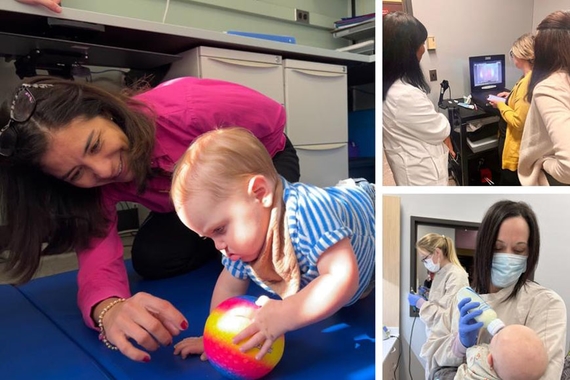Getting Speech Up to Speed
Children start learning to communicate through speech almost immediately after birth, beginning with coos and babbles as an infant and developing into full utterances as they mature. Parents, family members, and other adults then contribute to the growing child’s language development through conversation and verbal cues. For some, however, these cues don’t properly teach language conventions, and those children find themselves falling behind the developmental pace of their peers.
Lizbeth Finestack, associate professor in the Department of Speech-Language-Hearing Sciences, is focused on addressing that disparity. Through her Reducing Early Language Disparities program, Finestack is establishing the most efficient and productive way to assist the early language development of children with neurodevelopmental disorders.
Spotting the Need
She began her academic career at the University of Minnesota in 2009, but Finestack’s early work as a clinician in a private school for children with learning disabilities first opened her eyes to the need for changes in language intervention. As she worked alongside children in this setting, she began to see the disparities in language development, specifically in children with neurodevelopmental disorders.
In 2016, she partnered with Dr. Scott McConnell of the Department of Educational Psychology to develop a proposal for the University of Minnesota Grand Challenge Exploratory Research project. Their interdisciplinary research proposal, “Reducing Early Language Disparities: A Key to Lifelong Academic, Socioeconomic, and Health Success,” had “plans to expand the scope, investigators, and community connections of existing research... with a clear and strong focus on early development of children at risk in ways that set the foundation for life-long learning and social wellbeing,” according to a 2016 article by MNTalks.
Dr. Finestack and her team of graduate and undergraduate students still work regularly with the children participating in the study to continue the research mission.
Speech in Action
Finestack describes her research as a “program focused on developing new child language intervention techniques, better understanding the language profiles of children and adolescents with differing neurodevelopmental disorders, and measuring intervention outcomes of individuals with different language and cognitive profiles.” On a smaller level, her research focuses on finding the most effective and efficient way to teach language to children starting from a young age.
Children in the research program work through language using several different intervention techniques, including recasting, explicit techniques, and more.
Recasting is a method where parents and educators repeat utterances from the child in the correct grammatical way to showcase the proper structure of the phrases. For example, after a child says “she write,” a parent might respond “yes, she writes.” According to Finestack, this is the most common way to teach and support language development.
Explicit techniques refer to describing the rules or patterns that guide the use of grammatical tenses. Children are told that if a person “works” in the past, for example, they must add an “ed” sound to make the verb “worked.” Finestack equates this manner of teaching to the way teenagers learn second languages in high school when they are given a conjugation chart.
She says that she and her team hope that “if we increase the input [of examples of correct language forms], we’ll give the kids lots of models.”
For Finestack, her research goes beyond simply finding effective techniques for communication. By establishing the best techniques, she says that she is “improving clinical services for kids so that they have better outcomes.” Children with neurodevelopmental disorders will be moving at the same pace as their peers, rather than constantly attempting to make up for lost ground.
In Finestack’s eyes, a public knowledge of the importance of early language-learning support and how it plays into academic, social, and communication spheres is crucial to a child’s language development. Implementation of the best techniques can then affect a child’s trajectory in life, according to Finestack. It means setting up every child for an equal chance at success in the future.
This story was written by an undergraduate student in CLA.



